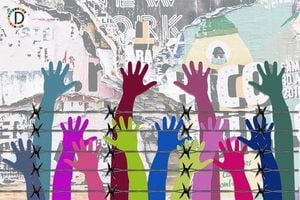On November 20, 2025, as dusk settled over San Francisco, dozens gathered outside City Hall, candles flickering in the chilly air, to mark Transgender Day of Remembrance. The annual observance, which began in San Francisco in 1999, has always been a somber occasion—a time to honor the lives lost to anti-transgender violence and reflect on the ongoing struggles of the trans community. But this year, the urgency and gravity of the commemoration felt especially acute, not just in San Francisco but in cities and communities across the globe.
San Francisco has long been a sanctuary for transgender people seeking refuge from discrimination, a place where the echoes of the 1966 Compton Cafeteria Riot still resonate. That riot, which erupted in the city’s Tenderloin district, was among the earliest acts of civil disobedience by trans people in the United States. Decades later, the city’s role as a safe haven remains vital. “Any time, you could experience someone who is just incensed and hateful just because you’re existing,” Cherry Javier, a local trans advocate, told KGO. For Javier and many others, Transgender Day of Remembrance is both a day of grief and a call to action—a moment to remember friends lost to violence, poverty, or systemic neglect, and to recommit to the fight for a safer, more just future.
Unfortunately, the challenges facing the trans community have only multiplied in recent years. According to KGO, trans people continue to endure disproportionate rates of poverty, homelessness, and violence. “If we’re lucky, it’s from old age, but unfortunately it’s more than likely from systemic issues or just straight up violence,” Javier said. The statistics are sobering: between October 1, 2024, and September 30, 2025, 281 trans and gender-diverse people were reported murdered globally, according to Transgender Europe and Central Asia (TGEU). What’s even more alarming is that 14% of those victims were leaders and activists—a 5% rise from the previous year, and an 8% increase since 2023. The violence, it seems, is not just random but increasingly targeted at those who dare to speak out or organize for change.
The situation is hardly confined to the United States. In the United Kingdom, the past year has been described as one of the darkest political moments the trans community has ever faced. Jess O’Thomson, trans rights lead at the Good Law Project, reflected on the impact of the UK Supreme Court’s April 2025 decision, which redefined “sex” in the Equality Act 2010 as biological sex. This ruling, part of the For Women Scotland Ltd v The Scottish Ministers case, effectively excludes transgender women with Gender Recognition Certificates from being recognized as women under the law. According to The New Feminist, this new legal interpretation has led to job losses, violence, and exclusion for not only trans people but also cisgender and intersex individuals.
“Our actions and decisions are being picked apart, our experiences are being examined by individuals who don’t want to know us,” said Dee Whitnell, a trans activist and author, in an interview with The New Feminist. Whitnell described the atmosphere as more visceral than ever, with “more names added to the growing lists” of victims and a relentless stream of hate online. “You can’t scroll on social media without seeing article after article, hate comment after hate comment,” they said. The findings from TGEU’s Trans Murder Monitoring report confirm this grim reality, highlighting a dangerous global trend of escalating violence and hostility.
The legal and social climate has left many in the UK’s trans community feeling alienated and unsafe. O’Thomson shared that, following the Supreme Court ruling, discrimination has intensified—not just in the workplace but in everyday life. Many trans people are now considering leaving the country altogether. “It’s almost impossible to participate in normal life when you don’t know what toilet you can use,” O’Thomson wrote. The sense of despair is palpable: “Other friends confide in me that they have stopped planning, because they don’t think they will still be alive to make those kinds of decisions.” Reports of suicidal thoughts have surged, with many reaching out to organizations like the Good Law Project for support.
Healthcare access remains another critical issue. Long waiting lists and outright denials for gender-affirming care persist, compounding the sense of vulnerability and marginalization. The murder of Brianna Ghey, a teenage girl, in 2023 was a tragic reminder of the violence that trans people, especially young people, continue to face. Yet, as O’Thomson pointed out, the current wave of hostility is not an abrupt shift but the result of years of growing transphobia and political attacks.
Across the Atlantic, the presidency of Donald Trump has also cast a long shadow. According to O’Thomson, Trump’s attacks on equality, diversity, and inclusion have led to the withdrawal of funding and support for the queer community in the US. The era of performative allyship—rainbow flags and corporate displays of support—has largely faded. Now, those who are willing to stand up as allies often face significant backlash. “It now takes real bravery to be an outspoken trans ally, when those allies are needed more than ever,” O’Thomson observed.
Social media platforms, too, have come under fire for failing to protect the trans community. In April 2025, Meta’s independent Oversight Board ruled that anti-trans posts would be allowed on its platforms, though it recommended removing anti-transgender rhetoric from hate speech policies. The result, as Whitnell explained, has been a chilling effect: “So many organisations are pushing out trans employees or making it harder for them to exist within the workplace. In the media and influencer world, we have seen a huge decrease in brands wanting to work with trans people and show their allyship.” For trans content creators, the risks are both professional and personal, with safety and mental wellbeing constantly in jeopardy.
Despite these daunting challenges, there are glimmers of hope. Both in the United States and the United Kingdom, the trans community and its allies have responded to adversity with solidarity and resilience. “Despite just how bad things have gotten, I think I feel more hopeful than I have in years,” O’Thomson wrote. “I have watched how—faced with the biggest attack on our rights there has ever been—our community has come together to take care of each other, and to fight back.”
Transgender Day of Remembrance, then, is not just a day of mourning but a day of resolve. As Mariah Moore of the Transgender Law Center told KGO, the impact of anti-trans legislation and legal decisions “will ultimately impact a lot of different communities.” The fight for trans rights, in other words, is a fight for justice and dignity for all.
For those who have witnessed or experienced hate crimes, authorities urge contacting the police, Crimestoppers, or visiting the True Vision website. In emergencies, dialing 999 remains the lifeline.
This year’s Transgender Day of Remembrance stands as both a memorial and a rallying cry. The names read aloud at vigils are a stark reminder of the work still to be done—but also a testament to a community that refuses to be silenced or erased. As the candles burned outside San Francisco City Hall and in countless vigils worldwide, the message was clear: solidarity, remembrance, and hope endure.




